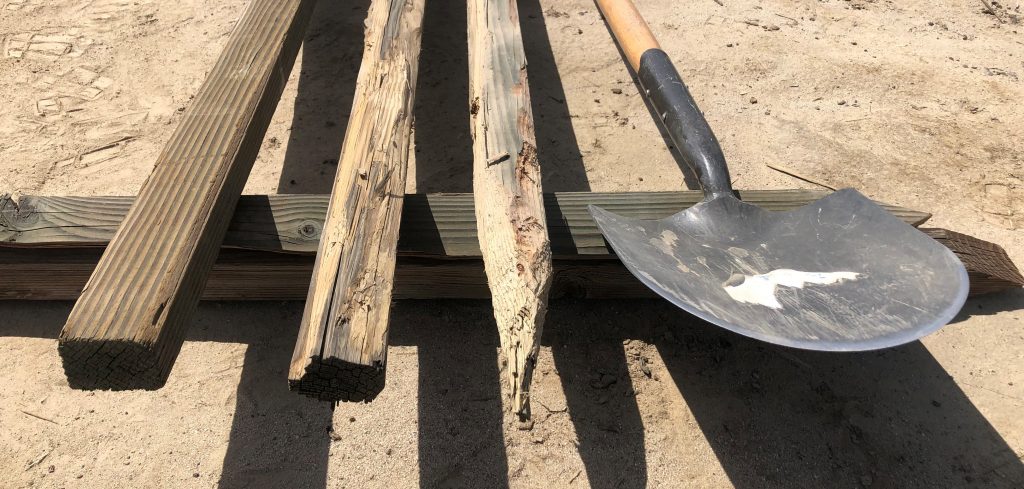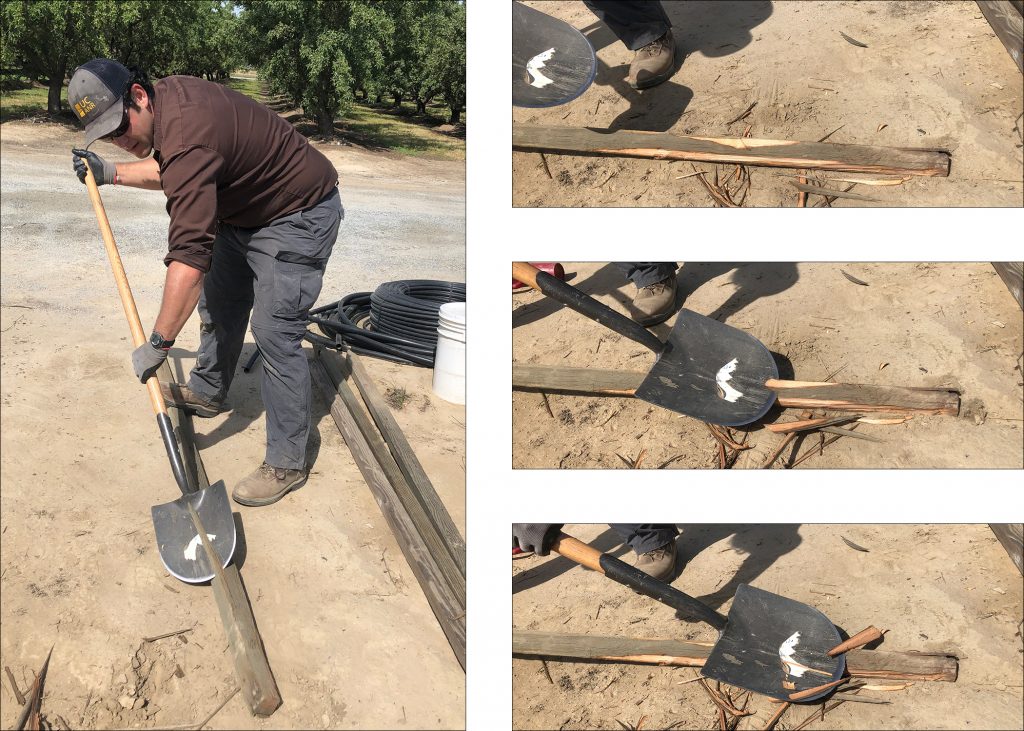Written By Cameron Zuber, Staff Research Associate, UCCE Merced
Have some tree stakes that do not fit into your post-pounder or lost the point making it hard to drive into the soil? Try using a shovel to shave down the stake first.

Using a shovel is an easy and safer alternative to axes or knives as the cutting motion and blade edge is away from the user. It is also readily available and something people normally are willing to be a bit rough with when using. A proper technique when using a shovel to shave down a stake is:
- Place the stake on flat ground.
- Stand on the end you are not shaving down and place your back foot on the stake. Have your other foot planted firmly on the ground to help you balance when shaving the stake.
- Place your hands comfortably far apart along the handle. One hand should be towards the top of the handle to provide more force when shaving. The other should be place as close to the shovel’s blade to help direct the shovel tip to properly hit the stake.
- Angle the shovel’s blade at an approximate 20° to 30° angle from the stake. If the stake is rectangular, direct the shovel’s tip at the corners of the stake not the flat edges.
- Starting away from the cut end of the stake, push the shovel forward working with the grain of the wood. Continue shaving down, working towards the cut end of the stake.
- If trying to make into a point, angle the shovel’s blade at an approximate 45° angle as you get closer to the cut end of the stake. Otherwise keep the same 20° to 30° angle as you work towards the cut end.
- Repeat on all corners of rectangular stakes or along the circumference of rounded the stake until you reach the desired shape and size.

When using this technique, remove smaller pieces of wood as trying to remove too much wood may split the wood so severely it can no longer be used. Worse would be causing slight damage to the remaining wood weakening the overall structure of the stake. This could cause easier breakage after installing in the field. This wastes the effort of shaving and installing the stake, so take your time.
Most shovels will work when using this technique, but if you do have a choice try selecting a shovel with most of these characteristics:
- Rounded, blunt tip: Round tips are more forgiving when directing the shovel blade into the stake. Pointed shovels can work, but you need to take extra care to make sure the pointed tip hits the desired spot on the stake. If missed, the shovel tends to get diverted away from the stake due to the angled tip of a pointed shovel.
- Heavy blade: A heavier blade will help generate more force when driving the shovel into the stake, cutting down on the energy you need to exert.
- Straight shovel: Having a blade more in-line with the handle makes it easier to drive the blade into the stake and forward towards the cut end. If the blade and handle are at a sever angle, you may need to adjust how you drive the shovel into the stake.
- Sharp tip: Sharpening your shovel’s tip is generally good to do semi-frequently anyway. Sharper tips allow for easier digging and cutting roots, as well as, shaving stakes.
For more information on how to properly stake and tie almond trees, see David Doll’s section in this presentation about developing and managing a young almond orchard (http://www.almonds.com/sites/default/files/content/attachments/Tu-308%20300pm%20SESSION%20Slides%20V2.pdf). His section is located towards the end of this presentation.
Special thanks to Brent Holtz (Farm Advisor with UC Cooperative Extension in San Joaquin County) who showed me this technique and for assisting with capturing the photos used in this article.
The Almond Doctor Field Note is a series of posts that will cover observations made from the field by staff research assistants of the University of California Cooperative Extension office of Merced County. While Field Note posts may reference completed or on-going research, its intent is share notable observations from the field, not to summarize research findings or describe current recommended farming practices.

